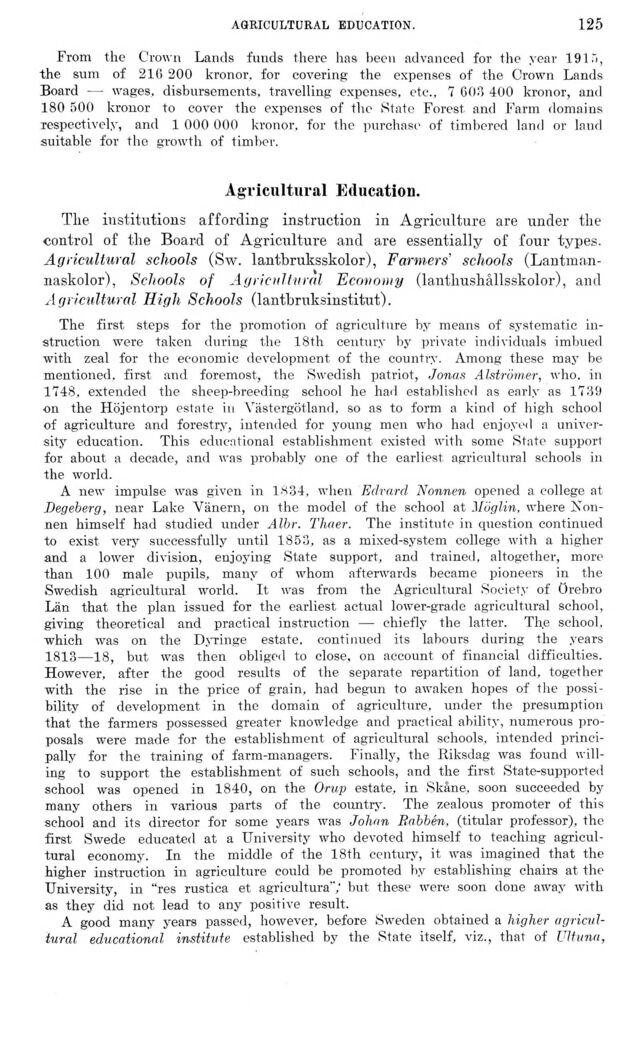
Full resolution (JPEG) - On this page / på denna sida - III. Rural Husbandry. Introd. by H. Juhlin Dannfelt - 4. Public and Private Institutions for the Advancement of Agriculture. Introd. by W. Flach - Agricultural Education. By L. Holmström

<< prev. page << föreg. sida << >> nästa sida >> next page >>
Below is the raw OCR text
from the above scanned image.
Do you see an error? Proofread the page now!
Här nedan syns maskintolkade texten från faksimilbilden ovan.
Ser du något fel? Korrekturläs sidan nu!
This page has never been proofread. / Denna sida har aldrig korrekturlästs.
agricultural education.
125
From the Crown Lands funds there has been advanced for the year 1915,
the sum of 21(3 200 kronor, for covering the expenses of the Crown Lands
Board — wages, disbursements, travelling expenses, etc., 7 603 400 kronor, and
180 500 kronor to cover the expenses of the State Forest and Farm domains
respectively, and 1 000 000 kronor, for the purchase of timbered land or land
suitable for the growth of timber.
Agricultural Education.
The institutions affording- instruction in Agriculture are under the
control of the Board of Agriculture and are essentially of four types.
Agricultural schools (Sw. lantbruksskolor), Farmers’ schools
(Lantmannaskolor), Schools of Agricultural Economy (lanthushållsskolor), and
Agricultural High Schools (lantbruksinstitut).
The first steps for the promotion of agriculture by means of systematic
instruction were taken during the 18th century by private individuals imbued
with zeal for the economic development of the country. Among these may be
mentioned, first and foremost, the Swedish patriot, Jonas Alströmer, who, in
1748, extended the sheep-breeding school he had established as early as 1739
on the Höjentorp estate in Västergötland, so as to form a kind of high school
of agriculture and forestry, intended for young men who had enjoyed a
university education. This educational establishment existed with some State support
for about a decade, and was probably one of the earliest agricultural schools in
the world.
A new impulse was given in 1834, when Edvard Nonnen opened a college at
Begeberg, near Lake Vänern, on the model of the school at Moglin, where
Nonnen himself had studied under Albr. Timer. The institute in question continued
to exist very successfully until 1853, as a mixed-system college with a higher
and a lower division, enjoying State support, and trained, altogether, more
than 100 male pupils, many of whom afterwards became pioneers in the
Swedish agricultural world. It was from the Agricultural Society of Örebro
Län that the plan issued for the earliest actual lower-grade agricultural school,
giving theoretical and practical instruction — chiefly the latter. The school,
which was on the Dyringe estate, continued its labours during the years
1813—18, but was then obliged to close, on account of financial difficulties.
However, after the good results of the separate repartition of land, together
with the rise in the price of grain, had begun to awaken hopes of the
possibility of development in the domain of agriculture, under the presumption
that the farmers possessed greater knowledge and practical ability, numerous
proposals were made for the establishment of agricultural schools, intended
principally for the training of farm-managers. Finally, the Kiksdag was found
willing to support the establishment of such schools, and the first State-supported
school was opened in 1840, on the Orup estate, in Skåne, soon succeeded by
many others in various parts of the country. The zealous promoter of this
school and its director for some years was Jolian Babbén, (titular professor), the
first Swede educated at a University who devoted himself to teaching
agricultural economy. In the middle of the 18th century, it was imagined that the
higher instruction in agriculture could be promoted by establishing chairs at the
University, in "res rustica et agricultura"; but these were soon done away with
as they did not, lead to any positive result.
A good many years passed, however, before Sweden obtained a higher
agricultural educational institute established by the State itself, viz., that of Ultuna,
<< prev. page << föreg. sida << >> nästa sida >> next page >>